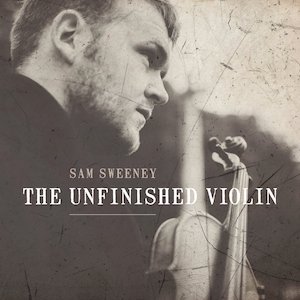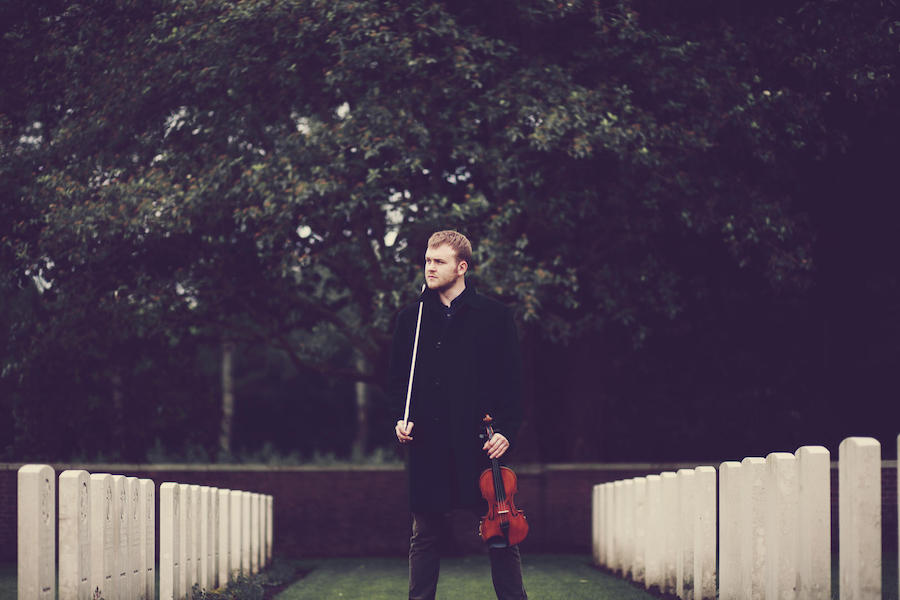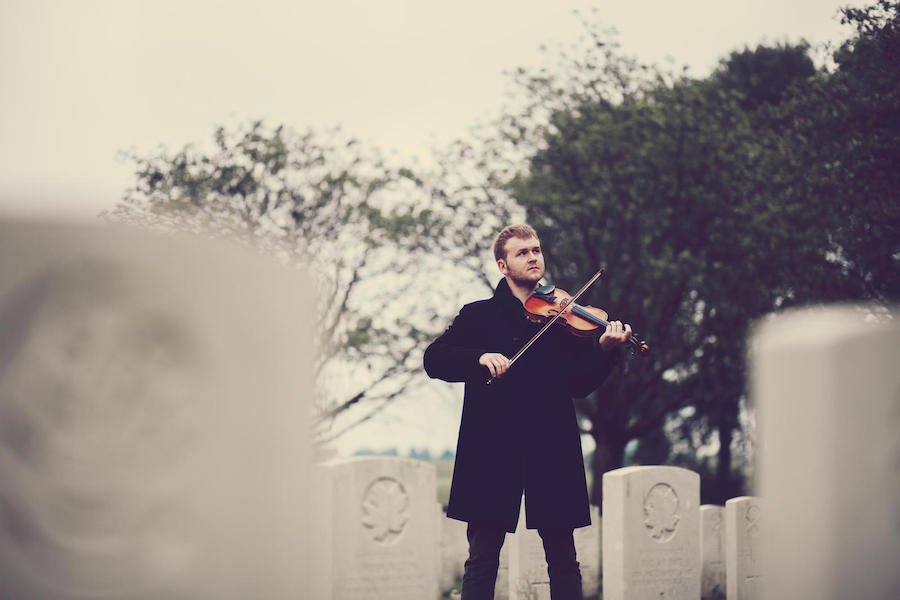 Sam Sweeney – The Unfinished Violin
Sam Sweeney – The Unfinished Violin
Universal-Island Records – 2 November 2018
To do justice to Sam Sweeney’s The Unfinished Violin album in a review means engaging with some complex and challenging themes. This is because the origins and genesis of this work reach back to the single most cataclysmic cultural-historical event in British history: the First World War. Arriving close to the approaching centenary of the war’s end, the album offers stunning perspectives on the ways that the war impacted on and completely reshaped Britain and continues to reverberate in cultural and everyday life to this day. In doing so, The Unfinished Violin makes a profound point about how the continuum of music connects past, present and future, continues to give a voice to the voiceless, and allows their and our stories to be told.
Given this is the case, I’d like to start at the end. The Unfinished Violin is a superb album. The quality of the musicianship and the sensitive and sympathetic reading of the songs collected on it means that it should rightfully be considered one of the best folk albums of 2018. It’s context and story, however, suggests that it has a good chance of being considered one of the most important too.
Origin Stories
There are origin stories, and there are origin stories. In one sense, The Unfinished Violin is the natural heir to the acclaimed live show Sam Sweeney’s Fiddle: Made in the Great War, which toured to acclaim between 2014 and 2017. In another, the album and the show were decades in the making. Both centre on the violin that the then-19-year-old Sweeney found in violin-maker Roger Claridge’s shop in Oxford. A man from Leeds called Richard S. Howard had commissioned the violin back in 1915. It had been blocked out and made, but never assembled. Bought at auction as a collection of pieces in an old manila envelope, Claridge had finally built the violin decades after had been initially intended. Enter Sam Sweeney. Entering the shop by chance, Sweeney fell in love with the instrument, bought it, and went on to use it to build his storied career including his well-documented time with Bellowhead and artistic director of the National Youth Folk Ensemble, his role as founder member of the instrumental trio Leveret, and his widely acclaimed position as one of the foremost instrumentalists in contemporary English Folk music.
It was when Sweeney began investigating the history of his instrument that he learned that Richard Howard had been a music hall performer. Called up in 1916, Howard died at the Battle of Messines on 7th June 1917 while fighting for the Duke of Wellington’s West Riding Regiment. This knowledge led to the development of the Made in the Great War show and now The Unfinished Violin album.
The Unfinished Violin
The album was largely recorded at Fairpoint Convention’s studio in Oxfordshire and Sam was joined by Rob Harbron, guitarist Jack Rutter, pianist Becky Price, double bassist Ben Nicholls and brass and string section – all of whom are deployed to superb effect. The idea was to use the Howard / Sweeney instrument in playing songs that might have been played at the time, and perhaps even by Howard himself. In lesser hands, this could have turned into a jingoistic overblown conceit. In Sweeney’s hands, it is by turns an elegiac, stirring and redemptive concept.
Opener Highland Soldier is a case in point. It was first collected in Sussex by composer George Butterworth, who died at the Battle of the Somme, the First World War’s hideous human monument to hidebound idiocy, almost unthinkable bravery and tragic, avoidable waste. As such, it sets the tone for the rest of the album. Sombre yet stately, it touches on the dialectic of the war as it appeared at the time: a glorious adventure that turned into a pitiful nightmare. St. Patrick’s Day’s lilting march touches on the multi-ethnic nature of the conflict in writing back into the story of the conflict the role of the Irish who fought on the British side. It also acknowledges almost by its inclusion the part that Ireland and the Irish played in making the Britain that the war destroyed. The role the Irish diaspora played in the building of Britain’s cities and infrastructure, industrial and agricultural wealth, empire and armed forces is a vital and underreported part of our island story. Sweeney is front and centre throughout, but he is ably and flexibly supported by the other featured musicians and their mutual musical sympathy enriches the material. A good example of the suppleness of the interplay is the subtle support given to the arrangement of Young May Moon from a piano and Harbron’s English concertina.
Folk music’s most powerful quality is its ability to connect – whether individuals within a community or disparate groups in a shared perspective. I wasn’t expecting this album to connect quite so profoundly to my own life and family history, however. It dis so quite unexpectedly when the main theme to The Girl I Left Behind Me strikes up. A popular dance tune during the First World War it became synonymous with the war and the soldiers in the trenches in the same way that many others like It’s a Long Way to Tipperary did. I know this song, but not as The Girl I Left Behind Me. My great-uncle used to sing it to me when I was a child in the North-East of England under the title ‘My Uncle Nick.’ He’d served in World War II but had heard the song from his father, my great-grandfather, who had served in World War I and gone through Gallipoli and the Dardanelles fiasco. My great-uncle’s version began ‘Oh, my Uncle Nick had a great big stick, and he used it for manslaughter / he killed ten thousand other men at the Battle of the Boiling Water…’ The melody is beautifully played by Sweeney here, but it instantly flashed me back to my great-uncle’s version, with its chronicling of the ever-escalating hair-raising adventures that ‘Uncle Nick’ went on to have.
In his ground-breaking 1961 masterpiece The Long, Long Trail, BBC producer Charles Chilton chronicled the way that the songs of the First World War were created or adapted by the soldier’s in the trenches to reflect their war. A classic example is the music-hall tune I Make a Man of You Yet, which went on to feature in the film Oh, What a Lovely War. Like the handing out of white feathers, the song was a deliberately cynical attempt to emotionally manipulate men into joining up. Soldiers at the time, however, saw through it, making up their own words to the melody and singing it in the trenches: ‘I don’t want to join the army / I don’t want to go to war. I’d rather stay at home / around the streets to roam / living on the earnings of a lady typist. I don’t want a bayonet in my belly / I don’t want my bollocks shot away / I’d rather stay in England / Merry bloody England / and fornicate my bloody life away.’
Chilton depicted how the music of the First World War reflected the way the overarching culture and powers that be wanted the war to be represented. But he also revealed the ways the soldiers themselves reworked those narratives to express their own views and lives. This began when he started researching his own father, who was killed aged 19 at Arras during the war. Many of the tunes featured in The Long, Long Trail were ones Chilton found in The London Library in an obscure book called Tommy’s Tunes: A Comprehensive Collection of Soldier’s Songs, Marching Melodies, Rude Rhymes, and Popular Parodies (1918). By turns sardonic, melancholy, ribald and peppered with strong language they indicated the degree to which soldiers reworked and reclaimed popular tunes to reflect their reality. Sweeney’s version of The Girl I Left Behind is a case in point. It is a wonderful version – sweet without being cloying, and with a rhythmic subtlety that alternates between joyous celebration and wistful nostalgia, it is fantastically moving. I doubt Sweeney is referencing the dual life such songs had, but listening to it I couldn’t help thinking of where I first heard it, and my Great-Uncle’s experiences in the Second World War, and then back to my then-teenage great-grandfather perhaps learning and singing the words to ‘My Uncle Nick’ to the same tune to pass the time when on a troop-ship travelling out to the Dardanelles.
A large ensemble adds depth and heft to Sad I Am. a Scots tune composed in 1918 by one of the founding members of the Scottish Piper’s Association, Iain MacPherson. For me, this and the songs The Shell That Shook the Billet, The Battle of the Somme and the last track, Lament, forms the emotional core of the album. They are drawn from a book called The Pipes of War, which featured works written by Pipe Majors during the First World War. Sweeney himself has noted that ‘A lot of them probably haven’t been played since then, but I like the idea that some of these tunes were being played at that time, and that people like Richard Howard would have heard them or indeed played them.’ I feel there is a deeper resonance than simply reviving something lost at play here, however, powerful though that is. Anyone who has read about the role that the British Army played in British cultural life in the century or so before the First World War will know that in an age where regiments and battalions were drawn from specific regions and specific cultural catchment areas, the Pipe Majors or ‘Pipey’s’ were the keepers of the regimental traditions. Responsible for preserving and passing down the culture of the men of the draft, they preserved the links between a regiment, its catchment area and its cultural and military history. Given the scale of the empire, they frequently represented a link back to ‘home’ that would otherwise have been lost. Several of the stories in George MacDonald Fraser’s McAuslan trilogy, for example, outlines the function of Pipey’s in this regard (while also giving a trenchantly important reminder of the impossibility of judging a previous generation’s worldview from our own contemporary perspective). The mechanised slaughter of the First World War hoovered up the old regiments at a fearsome rate, however, before drawing in those who in previous generations of war would have been non-combatants. In this context, the core of Pipey’s tunes here represents not simply a nod to the army, but also an important statement about the way the war severed lives and continuities for everyone.
The album nods to the other cultures involved in the war, pulling in songs from Belgium, France, and Germany. It’s an important gesture, but the one point I would make about this is that if Sweeney was prepared to do this, then the net could have been cast more widely. St Patrick’s Day might write the forgotten Irish back into the story, but what of those Britain and others drew from their overseas Empires? Sepoys from the Subcontinent and Anzacs from the Antipodes are two cultures that spring to mind. This album should be enjoyed for what it is, without foreshadowing, but could a follow up see representations from other nations, cultures and song traditions from the conflict?
That said, all of the musicians involved make a fine job of joining their folk sensibilities together with the classical and operatic repertoire that Germany, for one, drew on for her wartime songs in his choices. Locksmarsch is paired with an English marching tune drawn from the seventeenth century’s Playford’s Musical Companion, while Eventide flows beautifully into Der Gute Kamerad, a traditional Swiss waltz that became co-opted by the German Army.
The melody of Monk’s Eventide was, of course, used for the hymn Abide With Me. Still used for military and civilian funerals and remembrance services it is a matter of record that it was sung in the trenches. It gives way to the elegiac Lament, which ends the album on a haunting note.
Aftermath
In his seminal book The Great War and Modern Memory, Paul Fussell made two central points about the First World War. The first was that the scale of the conflict was so great and the numbers of casualties so enormous that it rapidly became impossible to process. As a result of this, Fussell argues, the war fundamentally changed Britain’s national narrative and collective consciousness. Effectively traumatising the nation, the war left Britain with all of the symptoms of the trauma victim (dislocation, disassociation, disembodiment and disenfranchisement). Changing the way Britain thought about itself forever, these symptoms still resonate today.
Although Sam Sweeney doesn’t necessarily want The Unfinished Violin to be viewed solely in terms of the war, it is a good place to start considering its importance. Just as a trauma victim recovers their shattered identity fragment by fragment, one of the ways that the numbing scale of the slaughter and its profound effect on British culture can be dealt with is by humanising it. In highlighting Howard’s violin and story, Sweeney and this album do just that. It puts a human face on a war that dehumanised those who fought it and lived through it. Much of the recent media coverage and commentary on the First World War one hundred years on has been ill-considered. From Michael Gove’s ridiculous intervention into the teaching of the story of the war in classrooms to ill-judged ‘celebrations’ of it in the national media it should never ever be forgotten that the First World War was an avoidable event; that it caused hideous carnage; and that the profound cultural, economic, psychological and emotional damage it inflicted at the time is still felt today. Millions died when they shouldn’t have, all to settle a pissing contest between cousins. Without precedent in human history, it was a hideous, tragic, cataclysmic event. The millions of silent dead scream the danger of ever wrapping yourself in a flag and it beggars belief that one hundred years on the old lie has been allowed to resurrect itself. It is not, and it has never been a great and noble thing to die for one’s country. Those whose names adorn memorials in town squares and churchyards all over Britain would tell you that it is far better to live for something – country, family, friends – than die for nothing. In that context, The Unfinished Violin is a powerful and moving antidote to much of the ways the war has been portrayed and sold in recent years. It is also a powerful and moving paean to those who lived through it and died in it.
To end at the beginning, then, we live in a golden age of folk music. There is more of it about than ever before, and it’s never been easier to access. There are good and great albums by interesting artists working closely with powerful themes that they are thoroughly and engrossingly engaged with. Among the good albums released in any given year, there are a handful that go on to become landmarks. Only time will tell if this is the case with The Unfinished Violin. It certainly deserves to be one. Not simply because of the points made above, but also for this: by using Howard’s violin to draw attention to his story, Sweeney also draws attention to the album’s most powerful point: that the music continues although the players do not, and that we pick it up, add to it, and become part of it for the brief time we are here, before laying it down for others. The music allows us to see them and will allow others in the future to see us as we were too. As such, this album is vital and powerful, and simply gorgeous.
Pre-Order The Unfinished Violin via Amazon
A track from the album can be heard tonight (26th September 2018) on BBC Radio 2 – The Folk Show with Mark Radcliffe which airs at 20:00.
Album Launch Show
The following album launch shows have been announced:
Bristol Album Launch
Thu, Dec 13 @ 7:30PM – The New Room, Bristol (Tickets)
Sheffield Album Launch
Fri, Dec 14 @ 7:30PM – TBC – The Drama Studio, Sheffield
London Album Launch
Sat, Dec 15 @ 8:00PM – Kings Place, London (Tickets)
https://www.samsweeneymusic.com
Photo Credits: Elly Lucas



